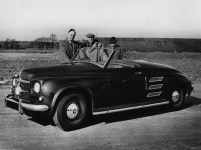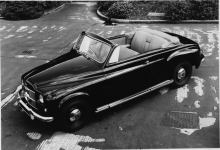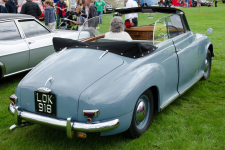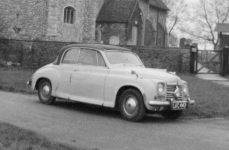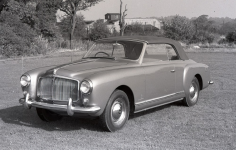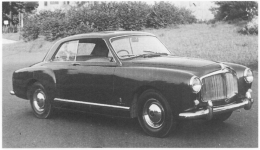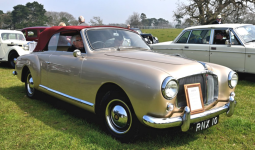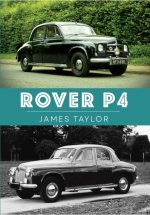Before the Second World War, Rover offered some models with delightful drophead coupé bodies that were coachbuilt by Salmons & Sons, who used the Tickford brand name. Prototype Tickford drophead bodies were built for the post-war P3 models, too, but the P3s’ production life was too short to justify a catalogued model.
However, Rover pursued the idea of a drophead coupé for the P4 models. Again, no production cars followed, but some very attractive prototypes were built. As the celebrations around 75 years of the P4 take place this weekend, I thought I should take a look at them.
Thanks for reading this post. It’s number 99 in the series that I started in July 2022. Please click the “Like” button if you enjoy it. If you want to share it or copy it, go ahead – but don’t forget to acknowledge where you found it (James Taylor's facebook page), and remember that “shares” do not automatically copy over the Comments and therefore the pictures that are included in them.
ROVER P4 DROPHEADS AND COUPÉS
The Tickford prototypes
The first of the drophead designs for the P4 grew out of the work done to build the first gas turbine car, JET 1. Rover asked Tickford to make its special body which, because of the mid-mounted engine, had to be an open car rather than a saloon.
The sleek two-door body that Tickford delivered was a great success, and there can be little doubt that it revived Chief Engineer Maurice Wilks’ enthusiasm for a new Rover drophead coupé. It was probably not long after JET 1 was revealed to the public in March 1950 that he asked the coachbuilder to design and build a three-position drophead coupé body for the P4, using the lines of JET 1 as far as possible. For good measure, he also asked for a fixed-head version of the same design.
Tickford’s first prototype was a Black drophead coupé, which was back at Solihull by early August 1950. It was stunningly attractive – and it certainly attracted the attention of the local Solihull MP, Sir Martin Lindsay. To cut a long story short, he persuaded Rover to sell it to him, which they did in late October after first registering it as KNX 518. Many years later, Sir Martin recalled paying £1000 for it, which was something of a bargain when a standard P4 saloon cost just over £1163! No doubt the knowledge that two more cars were on order from Tickford made Rover less reluctant to part with the car than they might otherwise have been.
It was probably in August that two more 75 saloons were pulled from the assembly lines and delivered to Tickford for that company to work its magic. One became a second drophead coupé, and the other its fixed-head counterpart. The drophead was finished in Pastel Blue; the fixed-head was in a non-production light grey colour with a roof covering of rubberised canvas duck material that made it look like a drophead coupé from a distance. This car had a large, wrap-around rear window that was divided into three sections by vertical chromed strips and was undoubtedly the inspiration for the new rear window on the 1955-model P4 saloons.
Rover seem to have used these cars on trade plates while doing their evaluation. However, by summer 1951, a decision had clearly been made not to put them into production. Rover registered the fixed-head car as LAC 447 in May before selling it on to the Henlys dealership in London. The drophead became LOK 918 in July and was probably registered by Collier’s of Birmingham, another major Rover dealer. Both cars were subsequently sold to customers, but only the drophead survives today; the fixed-head car was scrapped some time around 1970.
Exactly why the project was brought to an end is not clear, although one possibility is that the cancellation during 1951 of the contract for Land-Rover Station Wagon bodies from Tickford led to a situation where Rover did not feel they could negotiate another contract with the company. Another possibility is that Maurice Wilks believed it would be preferable to go for a more glamorous body design than could be achieved on the basis of the production saloon body – and his next move would certainly support that suggestion.
However, Rover pursued the idea of a drophead coupé for the P4 models. Again, no production cars followed, but some very attractive prototypes were built. As the celebrations around 75 years of the P4 take place this weekend, I thought I should take a look at them.
Thanks for reading this post. It’s number 99 in the series that I started in July 2022. Please click the “Like” button if you enjoy it. If you want to share it or copy it, go ahead – but don’t forget to acknowledge where you found it (James Taylor's facebook page), and remember that “shares” do not automatically copy over the Comments and therefore the pictures that are included in them.
ROVER P4 DROPHEADS AND COUPÉS
The Tickford prototypes
The first of the drophead designs for the P4 grew out of the work done to build the first gas turbine car, JET 1. Rover asked Tickford to make its special body which, because of the mid-mounted engine, had to be an open car rather than a saloon.
The sleek two-door body that Tickford delivered was a great success, and there can be little doubt that it revived Chief Engineer Maurice Wilks’ enthusiasm for a new Rover drophead coupé. It was probably not long after JET 1 was revealed to the public in March 1950 that he asked the coachbuilder to design and build a three-position drophead coupé body for the P4, using the lines of JET 1 as far as possible. For good measure, he also asked for a fixed-head version of the same design.
Tickford’s first prototype was a Black drophead coupé, which was back at Solihull by early August 1950. It was stunningly attractive – and it certainly attracted the attention of the local Solihull MP, Sir Martin Lindsay. To cut a long story short, he persuaded Rover to sell it to him, which they did in late October after first registering it as KNX 518. Many years later, Sir Martin recalled paying £1000 for it, which was something of a bargain when a standard P4 saloon cost just over £1163! No doubt the knowledge that two more cars were on order from Tickford made Rover less reluctant to part with the car than they might otherwise have been.
It was probably in August that two more 75 saloons were pulled from the assembly lines and delivered to Tickford for that company to work its magic. One became a second drophead coupé, and the other its fixed-head counterpart. The drophead was finished in Pastel Blue; the fixed-head was in a non-production light grey colour with a roof covering of rubberised canvas duck material that made it look like a drophead coupé from a distance. This car had a large, wrap-around rear window that was divided into three sections by vertical chromed strips and was undoubtedly the inspiration for the new rear window on the 1955-model P4 saloons.
Rover seem to have used these cars on trade plates while doing their evaluation. However, by summer 1951, a decision had clearly been made not to put them into production. Rover registered the fixed-head car as LAC 447 in May before selling it on to the Henlys dealership in London. The drophead became LOK 918 in July and was probably registered by Collier’s of Birmingham, another major Rover dealer. Both cars were subsequently sold to customers, but only the drophead survives today; the fixed-head car was scrapped some time around 1970.
Exactly why the project was brought to an end is not clear, although one possibility is that the cancellation during 1951 of the contract for Land-Rover Station Wagon bodies from Tickford led to a situation where Rover did not feel they could negotiate another contract with the company. Another possibility is that Maurice Wilks believed it would be preferable to go for a more glamorous body design than could be achieved on the basis of the production saloon body – and his next move would certainly support that suggestion.

